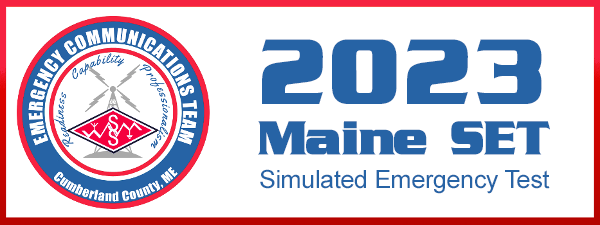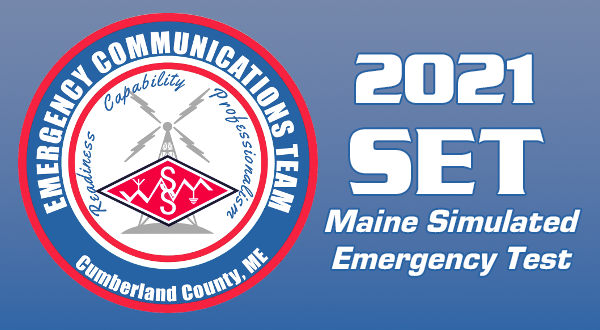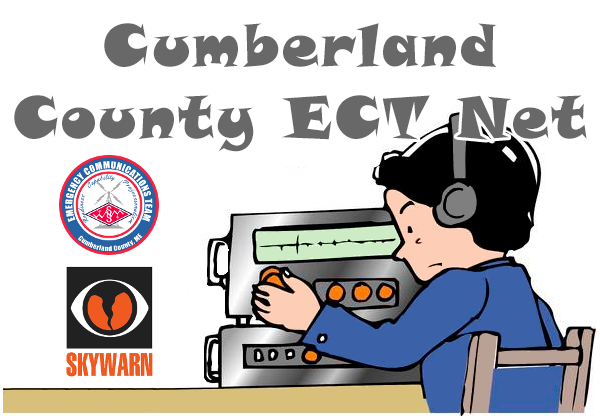
During a 24-hour period beginning at noon on Friday, October 27th, and continuing through Saturday, members of the Wireless Society of Southern Maine Emergency Communications Team (WSSM-ECT) participated in a statewide drill to test their communications capabilities between various sites throughout Cumberland County and the state of Maine. The drill, known as the Simulated Emergency Test, or SET, is an annual exercise, sponsored by the American Radio Relay League, which encourages amateur radio operators from across the country to test their communications skills during a mock disaster.
During the SET, hams are required to quickly establish communications between various Emergency Operations Centers and exchange formal messages and traffic, which contain requests for supplies, medical information, or weather reports, or other information that may be of importance during a disaster. They do this via voice, Morse code, and digital two-way radio, on bands ranging from HF to UHF, as required.
The purpose of this year’s exercise was to test the ability to communicate intra-county and between counties, using various modes: V/U FM repeaters, VHF FM Simplex, V/U Digital, HF SSB, VHF Packet, HF Digital, and Winlink via VHF Packet and HF, with the following objectives:
- Test ability to activate group
- Establish an HF circuit with KE4UCW (Simulated State) and ISS ops
- Establish an HF circuit with other County EOCs
- Establish 2 Meter Simplex Comms within county and with adjacent counties
- Establish HF and 2 Meter Comms with N1RXR (Simulated NWS)
- Test EMA repeater coverage
- Ability to send and retrieve Winlink traffic
- Relay simulated requests for support to MEMA and/or adjacent county EOCs
TASK
Tim Watson, ARES EC for Cumberland County, said afterwards, “We accomplished all of our tasks, and although it exposed a few deficiencies, we also learned quite a bit about VHF/UHF coverage in the western part of the county, and discovered that we can use peer to peer Winlink as a reliable means of sending traffic if the nodes and/or digipeaters are unreachable. Thanks to everyone who took time out of their weekend to help us out!”
Several operators (listed below), were deployed to shelter locations, where they tested various forms of communications, including FM simplex, UHF repeater, Packet Winlink, HF (on both 40 and 80 meters), and the EMA repeater, if equipped to do so. They communicated with Net Control at the EMA Bunker in Windham, with adjacent counties, direct with the Maine Emergency Communications net on HF, and via Packet Winlink.
Peter Hatem KC1HBM – deployed to South Portland High School / South Portland Community Center. Peter tested HF SSB, FM Simplex, V/U repeaters, EMA repeater, and digital voice via DMR and Fusion simplex.
Tom Mahon AB1ND – deployed to Westbrook High School. Tom tested FM Simplex and V/U repeaters.
Brad Brown, Jr. KC1JMH – deployed to Lakes Region High School (in Naples, ME), and Bridgton Hospital. Brad tested HF SSB, FM Simplex, V/U repeaters, EMA repeater, and Packet Winlink.

Todd Rodgers KC1SQ – deployed to Gorham Middle School. Todd tested HF SSB, FM Simplex, V/U repeaters, and the EMA repeater.

A unique task this year was to test the range of the EMA repeater, which is in the 155 MHz band. It had remarkably good coverage, especially to the western reaches of Cumberland and York counties.
“We found, in some cases, that FM simplex was more reliable than the UHF repeater, and in one instance, when Brad KC1JMH was unable to reach any Packet nodes from Lakes Region High School, we attempted Peer-to-peer (Simplex) Winlink, and it was successful,” Watson added.
“Peter KC1HBM reported having some difficulties setting up one of the BuddiPole antennas in the windy conditions, and we found that the BuddiPole that he used didn’t have the instructions in it for the 80m NVIS configuration, which is something we’ll be sure not to forget in the future,” continued Watson.
“I’m proud that our team accomplished their objectives and we even learned a few things that we didn’t anticipate, so the 2023 SET was a huge success.”
Thanks also to Jim Fraser KB1SDK, who assisted at the EMA on Saturday, Chris Wheeler, LEPC Liaison at CCEMA, who provided some realistic resource requests, and to everyone who checked into our SET nets Friday evening through Saturday.



